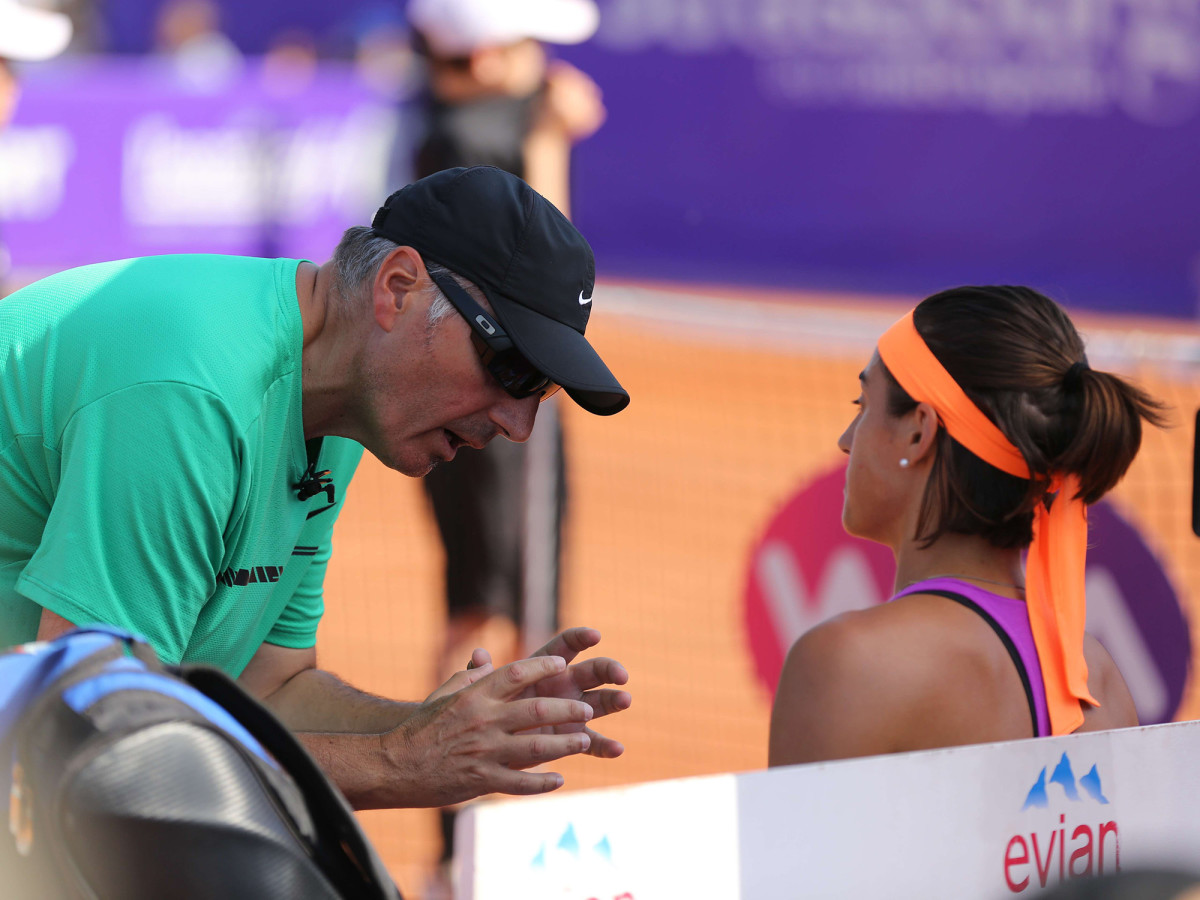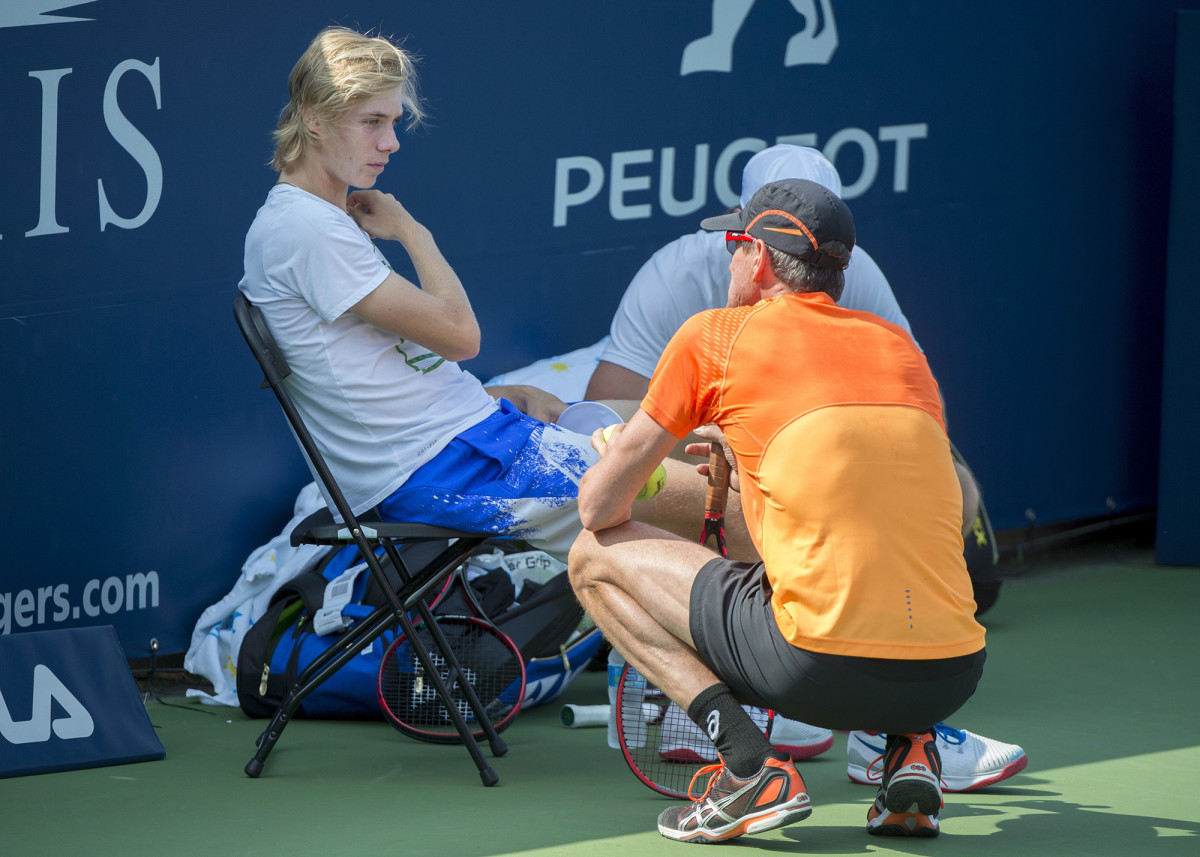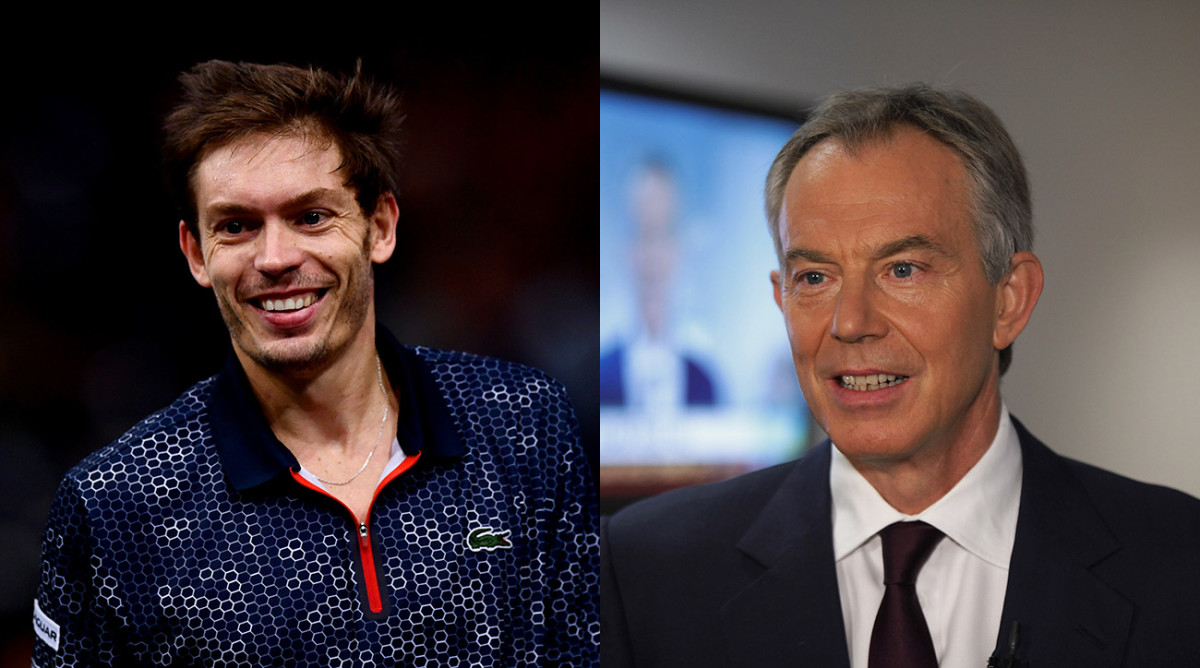Mailbag: The Case Against On-Court Coaching

Housekeeping….
1. The most recent podcast: Talking tennis with Dirk Nowitzki.
2. Next up, talking Battle of the Sexes with Billie Jean King and Emma Stone.
3. Lots of great questions this week. But first, this has been on my mind so I thought I would do something I don’t do enough and write a proper column. Your indulgence is appreciated…questions and answers follow if you want to skip down.
Like time, tide and the fatuousness of the pre-match interview, there was a numbing predictability to Rafael Nadal’s patterns. It was the first set of semifinals of the 2017 U.S. Open and Nadal sent every ball to the backhand side of his opponent, Juan Martin del Potro. Yes, this enabled Nadal to access his opponent’s weaker wing. But del Potro readied himself accordingly, knowing shot after shot was going to one side of the court. Delpo won the first set 6-4.
And then Nadal exhibited one of the core virtues of a tennis champion. He adjusted. He self-corrected. He strategized. Specifically, Nadal started using the entire court. In particular, he began zinging his lefty forehand up the line to del Potro’s forehand. Sure, that meant Nadal was engaging the Delpo forehand, arguably the most fearsome weapon in the men’s game. But it was a brilliant tactic, the legacy of which was revealed in the scoreline: 4-6, 6-0, 6-3, 6-2.
Nadal, of course, would go on to win the U.S. Open, his 16th major singles title and second since June. This one will be recalled for his forehands and backhands. For his crushingly strong serving. For his volleys, terminally underrated as they are. Yes, for his fortuitous draw. But were it not for Nadal’s nimble ability to change strategy in the semis, it's possible he does not win. So good on Rafa.
It’s axiomatic that no sport does irony quite like tennis. This event was no exception. As Nadal was winning the title largely by dint of his independence and problem-solving, the tournament itself was quietly promoting antithetical values via in-match coaching.
Rafael Nadal Wins the U.S. Open and Royalty Returns to Men's Tennis
If you missed it—or, more likely, only kinda, sorta knew something was afoot—well, that was by design. Like most dubious pieces of legislation, the supporters didn't push it through so much as they snuck it through, surreptitiously joining it with less controversial bits of business. Before the U.S. Open, the USTA proudly announced that it was adding on-court serve clocks and changes to pre-match warmups for the qualifying rounds as well as for juniors, wheelchair and, strangely, legends. And, oh yeah, almost as an afterthought, in those events, there would also be an opportunity to confer with coaches during matches.
This was the equivalent of a Congressman drafting a sleepy, unobjectionable grain subsidy bill….and then grafting on to it a controversial new handgun policy. Want to add an electronic gadget that encourages players to abide by a rule already in place? Great. Want to crack down on bathroom breaks? Sure. Who’s arguing? But how does that somehow get bracketed with on-court coaching, a fundamental change to the very essence of the sport?

The changes were craftily marketed this as “innovation…to enhance the fans’ experience”—thus implying opponents were retrograde—but when pressed about backing such a radical policy change, organizers mentioned neither progress nor the customers. The main justification for in-match coaching? Here’s how USTA execs put it to (vocal on-court coaching critic, bless her) Mary Carillo: “We’re simply legalizing what’s going on anyway.”
Time for new talking points. First, this, of course, is cowardice. You don’t confront rule violations by waiving the rules. Everyone takes dodgy deductions, so why not just eliminate taxes? Cheating on line calls runs rampant in junior tennis, an issue that—to the USTA’s credit—it has identified and is addressing. Why is the organization waiving its moral authority with this brand of cheating?
But it also represents—to use a voguish phrase—a false equivalency. What indication is there that allowing periodic on-court coaching visits would eliminate signaling between points? If anything, wouldn’t a concession like this encourage more folks in the stands to flout the rules?
Everything You Need to Know about Laver Cup
Once this experiment was launched, the stats were shared: Out of 29,859 points played in qualies there were only 19 “Serve Clock violations.” In 224 matches there were only three “Warm-Up violations.” That didn't necessarily tell us much. Sure, it could indicate that the clock changed behavior and had the desired deterrent effect. But it could also indicate that time violations were never an issue to begin with.
But then we were told that 81.5% of the players “were observed to utilize coaching in match.” Which suggested precisely nothing other than this: You confer a new perk on the players; and they’ll take advantage of it. Offer them double-bounces, three serves, more prize money and all-you-can-eat-crab-legs in the players’ buffet and 81.5% of players might well “utilize” that too. That doesn’t mean it’s advisable.
How did we get here? An impeccably well-placed source, who was with the WTA at the time recalls that on-court coaching started mostly out of a reluctance to confront stars on their coaching violations. Some top players—pointedly, NOT Venus and Serena Williams—were clearly receiving signals and verbal advice from their coaches and the WTA wondered whether it wouldn’t be politically expedient to create the equivalent of an easement.
Serena Williams Shares First Photo of Daughter Alexis
This, though had to be messaged (to say nothing of massaged) so the WTA sold it as a “fan enhancement,” insisting that the crowd and television audiences and players themselves supported it. Time and again, journalists have asked to see the data on which this claim was based. We still await a response.
A short time later, it was suggested to me that there was another reason the WTA would tinker with tennis and promote on-court coaching. At the time the WTA was hoping for a sponsorship with a telecom firm; much as NFL coaches wear Motorola headsets, tennis coaches could wear sponsored mics and this was a way to integrate the product. Crass and transactional as this was—really, you’re going to change a fundamental principle for a potential Sony Ericsson deal?— the honesty was appreciated. Alas, no deal was forthcoming.
At WTA events outside the majors, on-court coaching persists despite embarrassing player after player, seldom showing athletes in triumphal moments —the winners aren't the ones asking for assistance—but rather portraying its players as delicate and emotional souls who need the support of others (invariably an older male) for guidance and calm.

Tennis has a complicated relationship with change and evolution. Tradition looms large. The most minor alterations are met, often, with resistance. And yet other more material changes go unchecked. Thanks to runaway string and racket technology, the tennis Nadal plays is scarcely recognizable from the sport played by Pete Sampras and Steffi Graf.
In truth, tennis is due for some “enhancements.” We’re even willing to allow that perhaps there’s a discussion to be had about including in-match coaching. Maybe there are virtues that elude us. Maybe an emphasis on coaching is a way to integrate more figures, enhance the role of, say, Jose Higueras and Paul Annacone, whose profiles don't match their contributions. If an emphasis on coaching brings more attention to Kamau Murray and colleagues, that’s a plus.
But introducing mid-match coaching is not a quick cosmetic fix on the order of a shot clock. This is a policy shift, so to speak, a major change that confronts one of the sport’s bedrock values. At the risk of overdramatizing, adding mid-match consultations tugs at the core question: “What is tennis?”
The Complex Rise of Sloane Stephens
In other sports and in other industries, a comparable proposal would merit real data, deep debate, measured discussion, and thought from all constituents. That does not seem to be the case here. Never mind a failure to gather meaningful input from the players. It’s unclear that the USTA’s own board of directors okayed this policy. I spoke with multiple board members. One had no recollection on an on-court coaching discussion. Another recalled that “it came up but in a discussion that was mostly about the shot clock.”
Again, here comes tennis irony. In their effort to kill off the self-sufficiency so fundamental to the sport, cabal suits acted like, well, tennis players. That is, they tried to solve a perceived problem by themselves, making a strategy decision independently, neglecting to confer with others.
Maybe they're just waiting for the next changeover.
Mailbag
Have a question or comment for Jon? Email him at jon_wertheim@yahoo.com or tweet him @jon_wertheim.
It was noted many times how far back Nadal stood to return Anderson’s serve. Probably more so on the ad side than the deuce. I kept thinking that Anderson should just hit an underhand drop shot serve. Had he hit it well, I think it would have been effective, and if nothing else it would keep Nadal from standing so far back. Do you think that he didn’t do this because it is considered un-gentlemanly, because he never practices a shot like this and didn’t think he could pull it off, or do you think it just never entered his mind to attempt it?
—Eric, San Diego
• It’s not particularly gentlemanly. Funny, I was speaking with Michael Chang about that last week. After duping Lendl at the 1989 French Open, guess how many more underhanded serves Chang hit during his career? Zero. Apart from the optics, I just don't think it would work. Nadal is really, really fast. Even positioned to return in his position a Greyhound trip away from the baseline, I suspect he would catch up to the underhand serve.
Would you happen to know who commentated with Sam Gore for the men's doubles final on Tennis Channel? He has a very distinct voice...almost sounded like Wayne Bryan?
—Shay
• Survey says…Mal Washington.
Rafael Nadal's 2017 U.S. Open Title Reignites the GOAT Debate
The Fed-Nadal head to head for 2017 is skewed because Fed ducked out on the clay season which probably would have resulted in at least 2-3 wins for Nadal. Also Federer admitted after he lost to Delpo that he probably couldn't have won the U.S. Open (i.e. I couldn't have beaten Nadal at the level he was playing). Nadal is the clear Player of the Year for 2017.
—Bob Romero, Monee, Ill.
• That’s essentially my argument. Federer fans—quite rightly—take issue with the head-to-head and note how many times Federer, say, played deep into tournaments while Nadal lost earlier; one reason many of their clashes have occurred on clay. I think some there’s some merit to this. But the reverse should hold up, too. When Federer absents himself from the entire clay season, doesn’t that distort the head-to-head as well?
Wow Jon you are finally joined by others writing about tennis with quality. What a rich state of affairs the SI.com/tennis page is in right now.
—J Babb
• Namechecks: Jamie Lisanti, Stanley Kay, Richard Deitsch, S.L. Price. Very nice of you to write that. And I couldn’t agree more heartily.
Shots, Miscellany
• The inaugural Laver Cup begins this week. Tennis Channel has you covered.
• Friend of Mailbag, former podcast guest and former Danish Davis Cupper Torben Ulrich will hold exhibit of Torben’s rice-paper paintings the month of November in Pasadena. (At the bottom of that link there’s also a little teaser to a film in progress about T. by the filmmaker Andreas Johnsen.)
• Another Friend of the Mailbag from the music world and former podcast guest, Fred Hersch, has a new memoir.
• Last week we referenced the passing Don Ohlmeyer. Turns out the person in question was “Don Tisdel.”
• Here’s Colette Lewis’ junior tennis wrap.
• Serena Williams pens a letter to her mom.
• Sloane Stephens, your 2017 U.S. Open champ, is playing Charleston.
• Sam from San Diego has lookalikes:

Nicolas Mahut, record holder for the longest match in tennis history, and Tony Blair, former British prime minister.
